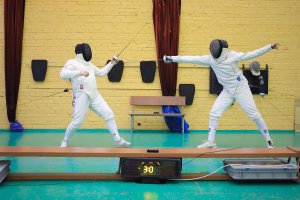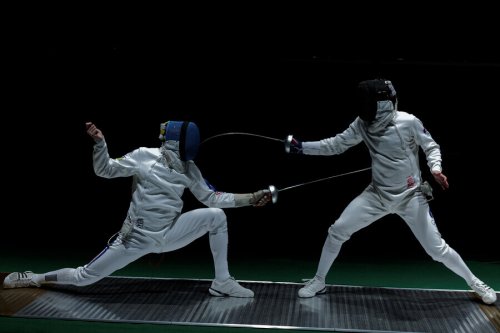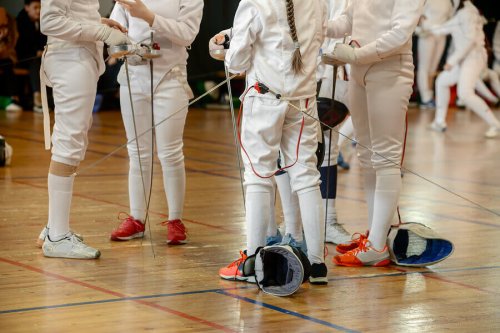The Basic Rules of Fencing

You tend to see fencing in some of the most important sporting events in the world. For example, it’s been an event at the Olympic Games as well as various world championships for a long time. The agility of its practitioners and its spectacular movements always turn heads at competitions. But, how many people really know what this sport is about?
It’s not a very common sport for people to practice. It’s usually not even included in schools’ athletic programs. That being said, it’s common for people to not be very knowledgeable about its rules.
In order to bring a bit of clarity to the matter, we’re going to give you the essential facts about it in this article. And who knows? Perhaps this may lead you to give it a try and start fencing yourself!
Objectives and basic rules of fencing
It’s not hard to see what the objective of fencing is even at a quick glance. The goal of the competitors in fencing – who are called fencers – is to touch the opponent with the saber. At the same time, they have to avoid the opponent touching them with it. Whoever manages to make contact with a valid part of the opponent’s body will get a point. Each round can last from 5 to 15 points.
People refer to fencing matches differently. Practice rounds are often referred to as “assaults.” On the other hand, fencers call competitive duels “bouts.” Finally, they call team competitions “matches.”
Types of fencing and points of contact
Experts divide this sport into three major types: foil, epee, and sabre. As you might guess, the major difference among these types is the weapon the fencers use during each. Nevertheless, the point-scoring contact areas are also different among them.
- Foil: this is the lightest and most flexible of the three. You can only use the top of the weapon to touch the opponent. Valid contact points are the chin of the fencing mask or the opponent’s torso. This variant forbids attacking the opponent’s limbs.
- Epee: here you can also only strike someone with the tip of the epee. However, you can strike any part of the opponent’s body. As opposed to the foil, there can be double touches. When that happens, each fencer receives a point.

- Sabre: the difference between this mode of fencing and others is that you can touch opponents with the blade. You can also do so with the back of the blade. As with foil, there’s no double touching.
In order to determine which fencer strikes the other first, the fencers wear metallic bodyguards. These send signals when the opponent’s weapon hits them. That way the judges can accurately count the points that the players score.
Fencing movements and equipment
The first thing you’re going to need to begin fencing is either a sabre, epee, or foil. That’s what’s going to determine the format you’re going to use. Of course, the number of participants, gender, and ages are also relevant factors. Safety, of course, is extremely important. That’s why each fencer should wear a helmet – one that also covers their face – and a protective vest.
With regard to the surface where the matches take place, they’re rectangular rings. These are 14 meters long by between one and a half and two meters wide. The rings are separated down the middle to split the two sides. There are also other lines located about two meters toward the outside. Those separate the guard line from the end of the ring.

If a fencer leaves the ring with both feet touching the floor, they’re penalized through the subtraction of a point. If they exit toward the side and involuntarily, the next match starts another meter away from the center. If it’s just one foot that leaves the ring, the referee pauses the duel so that the fencers can retake their positions.
It’s likewise forbidden to turn your back on your opponent. You also can’t use your arms to attack or defend under any circumstances.
Defensive and offensive actions
As far as the valid movements go, there are three offensive ones and one defensive one:
- Attack: the fencer extends their arm in an attempt to get the sabre to contact the opponent’s body.
- Riposte: this is a competitor’s reaction after having parried an opponent’s attack.
- Counter-riposte: this is a new reaction. Here it’s a counter-attack to the riposte.
- Parry: parries are movements that aim to block an opponent’s attack.
Fencing started out as practice sessions for knights who were trying to improve their sword fighting skills. Experts call this “historic fencing.” That’s how they differentiate it from the modern sport.
Without a doubt, this is a sport that people associate with the modern Olympics. In fact, it was there from the very beginning of the modern Games in Athens 1986. Female fencers, for their part, started to compete in 1924.
Without a doubt, this is a fantastic activity for the body and also for the mind. In fencing, it’s essential to be able to take correct decisions quickly. Have you tried it yet? Give it a chance and you won’t be sorry!
You tend to see fencing in some of the most important sporting events in the world. For example, it’s been an event at the Olympic Games as well as various world championships for a long time. The agility of its practitioners and its spectacular movements always turn heads at competitions. But, how many people really know what this sport is about?
It’s not a very common sport for people to practice. It’s usually not even included in schools’ athletic programs. That being said, it’s common for people to not be very knowledgeable about its rules.
In order to bring a bit of clarity to the matter, we’re going to give you the essential facts about it in this article. And who knows? Perhaps this may lead you to give it a try and start fencing yourself!
Objectives and basic rules of fencing
It’s not hard to see what the objective of fencing is even at a quick glance. The goal of the competitors in fencing – who are called fencers – is to touch the opponent with the saber. At the same time, they have to avoid the opponent touching them with it. Whoever manages to make contact with a valid part of the opponent’s body will get a point. Each round can last from 5 to 15 points.
People refer to fencing matches differently. Practice rounds are often referred to as “assaults.” On the other hand, fencers call competitive duels “bouts.” Finally, they call team competitions “matches.”
Types of fencing and points of contact
Experts divide this sport into three major types: foil, epee, and sabre. As you might guess, the major difference among these types is the weapon the fencers use during each. Nevertheless, the point-scoring contact areas are also different among them.
- Foil: this is the lightest and most flexible of the three. You can only use the top of the weapon to touch the opponent. Valid contact points are the chin of the fencing mask or the opponent’s torso. This variant forbids attacking the opponent’s limbs.
- Epee: here you can also only strike someone with the tip of the epee. However, you can strike any part of the opponent’s body. As opposed to the foil, there can be double touches. When that happens, each fencer receives a point.

- Sabre: the difference between this mode of fencing and others is that you can touch opponents with the blade. You can also do so with the back of the blade. As with foil, there’s no double touching.
In order to determine which fencer strikes the other first, the fencers wear metallic bodyguards. These send signals when the opponent’s weapon hits them. That way the judges can accurately count the points that the players score.
Fencing movements and equipment
The first thing you’re going to need to begin fencing is either a sabre, epee, or foil. That’s what’s going to determine the format you’re going to use. Of course, the number of participants, gender, and ages are also relevant factors. Safety, of course, is extremely important. That’s why each fencer should wear a helmet – one that also covers their face – and a protective vest.
With regard to the surface where the matches take place, they’re rectangular rings. These are 14 meters long by between one and a half and two meters wide. The rings are separated down the middle to split the two sides. There are also other lines located about two meters toward the outside. Those separate the guard line from the end of the ring.

If a fencer leaves the ring with both feet touching the floor, they’re penalized through the subtraction of a point. If they exit toward the side and involuntarily, the next match starts another meter away from the center. If it’s just one foot that leaves the ring, the referee pauses the duel so that the fencers can retake their positions.
It’s likewise forbidden to turn your back on your opponent. You also can’t use your arms to attack or defend under any circumstances.
Defensive and offensive actions
As far as the valid movements go, there are three offensive ones and one defensive one:
- Attack: the fencer extends their arm in an attempt to get the sabre to contact the opponent’s body.
- Riposte: this is a competitor’s reaction after having parried an opponent’s attack.
- Counter-riposte: this is a new reaction. Here it’s a counter-attack to the riposte.
- Parry: parries are movements that aim to block an opponent’s attack.
Fencing started out as practice sessions for knights who were trying to improve their sword fighting skills. Experts call this “historic fencing.” That’s how they differentiate it from the modern sport.
Without a doubt, this is a sport that people associate with the modern Olympics. In fact, it was there from the very beginning of the modern Games in Athens 1986. Female fencers, for their part, started to compete in 1924.
Without a doubt, this is a fantastic activity for the body and also for the mind. In fencing, it’s essential to be able to take correct decisions quickly. Have you tried it yet? Give it a chance and you won’t be sorry!
All cited sources were thoroughly reviewed by our team to ensure their quality, reliability, currency, and validity. The bibliography of this article was considered reliable and of academic or scientific accuracy.
- Reglamento básico de Esgrima. Esgrima Granada. http://www.esgrimagranada.org/antigua/escuela.php
- Reglamento Internacional para las pruebas. 2004. Federación Internacional de Esgrima. http://www.esgrimagranada.org/antigua/reglamento/reglamento_tecnico.pdf
This text is provided for informational purposes only and does not replace consultation with a professional. If in doubt, consult your specialist.








